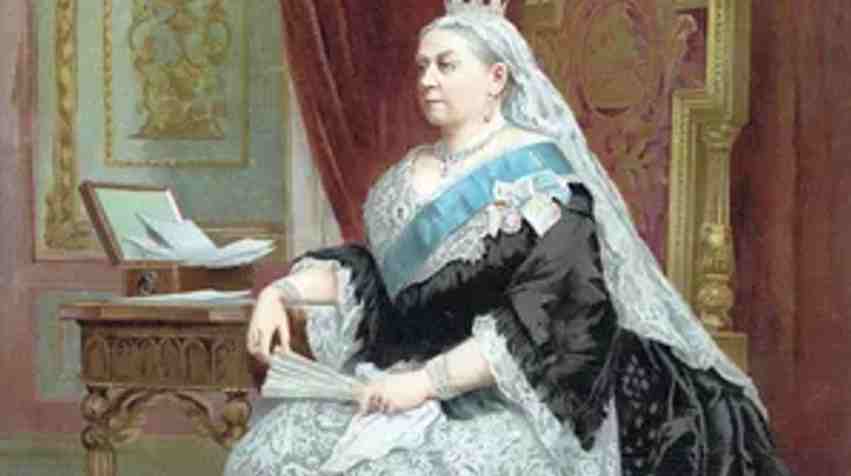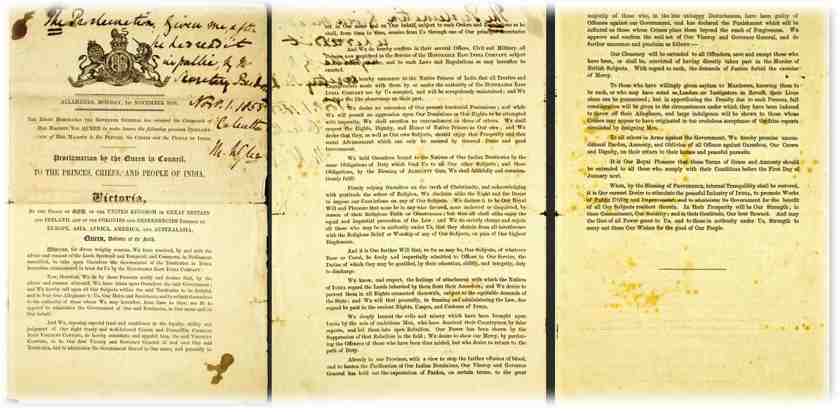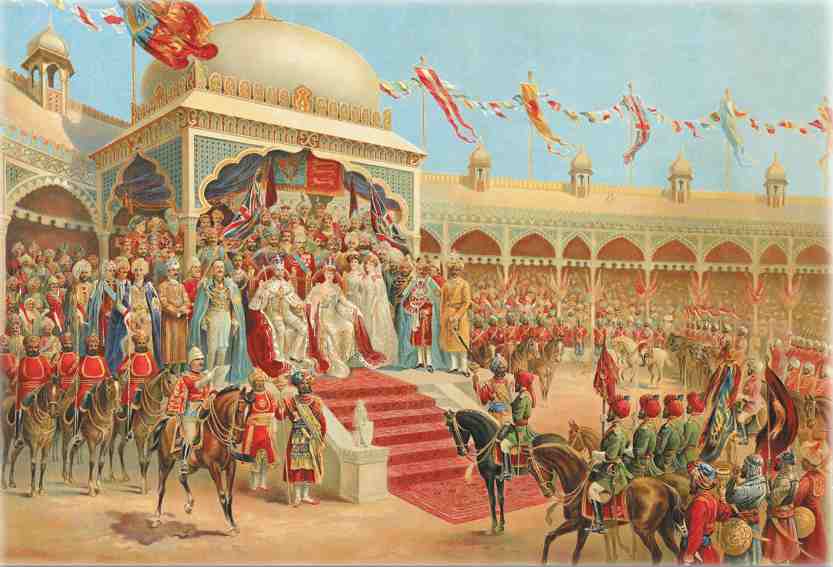- Umang Sagar
- History, Recent article
Queen Victoria Proclamation 1858, India

Introduction
The Queen Victoria Proclamation of 1858 marked a significant moment in the history of India as it formally marked the end of the rule of the British East India Company and the beginning of direct British rule in India.
The proclamation was issued by Queen Victoria on November 1, 1858, following the Indian Rebellion of 1857, also known as the Indian Mutiny or Sepoy Mutiny, which saw Indian soldiers in the service of the East India Company revolt against British rule. The rebellion was brutally suppressed, and the British government took direct control of India from the East India Company.
On November 1, 1858, a grand Darbar was held at Allahabad. Lord Canning sent forth the royal proclamation which announced that the queen had assumed the government of India. This proclamation was also known as the Magnacarta of the People of India. The proclamation was a public declaration by Queen Victoria, who was then the Empress of India, of the British government’s intentions and policies towards India. The proclamation promised to respect the religious beliefs and customs of the Indian people and to ensure that they were not disadvantaged in any way. It also promised to ensure the safety and security of Indian citizens and to provide justice and equality for all.
The Queen Victoria Proclamation of 1858 was an important step towards the establishment of a more modern and democratic system of governance in India, albeit under British control. It also paved the way for the eventual independence of India, which came about 90 years later in 1947.
Background

The British East India Company had been operating in India since the early 17th century and had gradually expanded its power and influence over the years, becoming the dominant political and economic force in the country. However, by the mid-19th century, the Company’s rule was facing numerous challenges, including economic instability, corruption, and growing unrest among the Indian population.
In the aftermath of the Indian Rebellion of 1857, which had threatened the stability of Company rule in India, the British government decided to take direct control of the country. The British Parliament passed the Government of India Act of 1858, which dissolved the British East India Company and transferred its powers and responsibilities to the British Crown.
The Queen Victoria Proclamation of 1858 was issued to mark this momentous occasion and to reassure the Indian people that their rights and interests would be protected under the new regime. The proclamation stated that the British Crown would assume direct responsibility for the governance of India and would work to promote the welfare and prosperity of the Indian people.
The proclamation also sought to address some of the grievances that had contributed to the rebellion of 1857. It promised to respect the religious beliefs and practices of the Indian people, uphold the rights of Indian princes and rulers, and abolish certain discriminatory practices, such as the practice of sati (widow burning).
The Queen Victoria Proclamation of 1858 marked a significant turning point in the history of India. It paved the way for the establishment of a centralized, British-controlled administration in India, and set the stage for the development of modern India under British rule. However, it also marked the beginning of a long period of political and social upheaval in India, as the country struggled to come to terms with its new status as a colony of the British Empire.
Text Of The Proclamation

We hereby announce to the Native Princes of India that all treaties and engagements made with them by or under the authority of the Honorable East India Company are by us accepted and will be scrupulously maintained, and We look for a like observance on their part. We desire no extensions of Our present territorial possessions; and while We will permit no aggression upon Our dominions or Our Rights to be attempted with impunity, We shall sanction no encroachment on those of others, We shall respect the rights, dignity, and honor of Native Princes as Our own; and we desire that they—as well as our own subjects—should enjoy prosperity and that social advancement, which can only be secured by internal peace and good government. We hold ourselves bound to the Natives of Our Indian territories by the same obligations of duty, which bind us to all Our other subjects, and those obligations by the Blessing of God, we shall faithfully and conscientiously fulfill…..
……And it is our further will that, so far as may be, our subjects, of whatever race or creed, be freely and impartially admitted to offices in our service, the duties of which they may be qualified, by their education, ability, and integrity, duly to discharge….
Objective
The Queen Victoria Proclamation of 1858 was a significant declaration made by the British monarch, Queen Victoria, which announced the end of the rule of the British East India Company in India and the beginning of direct British rule over the country.
The proclamation had several objectives, such as:-
1) Centralization of Power: One of the key objectives of the proclamation was to centralize power in the hands of the British Crown. The proclamation declared that the government of India would be administered directly by the British government, through a new Secretary of State for India, who would be appointed by the Crown.
2) End of the East India Company’s Rule: The proclamation marked the end of the East India Company’s rule in India and transferred the powers and responsibilities of the Company to the British Crown. The Company’s monopoly on trade with India was also abolished, allowing for greater competition in the Indian markets.
3) Protection of Indian Rights: The proclamation promised to protect the rights and privileges of the Indian people, including the right to practice their own religion and the right to own property. It also promised to abolish certain discriminatory practices that had been imposed on the Indian princes by the Company.
4) Improved Governance: The proclamation aimed to improve the governance of India by establishing a new administrative structure that would be more accountable to the British government. The British Crown took direct control of India’s administration, and a new governor-general was appointed to oversee the affairs of the country.
5) Promote British Interests: Another objective of the proclamation was to promote British interests in India, particularly in the areas of trade and commerce. The British government hoped to expand its economic influence in India and open new markets for British goods.
Overall, the Queen Victoria Proclamation of 1858 main objective was to centralize power in the hands of the British Crown and to promote British interests in India, while also promising to protect the rights and privileges of the Indian people. The proclamation marked the beginning of a new era in the history of India and set the stage for the country’s eventual independence from British rule.
Impact On East India Company

The Queen Victoria Proclamation of 1858 significantly impacted the British East India Company, which had ruled over India for more than two centuries. The proclamation marked the end of Company rule in India and transferred the powers and responsibilities of the Company to the British Crown.
Here are some of the major impacts of the proclamation on the East India Company:
Dissolution of the Company: The proclamation led to the dissolution of the British East India Company, which had been the governing body in India since the early 1600s. The Company’s monopoly on trade with India was also abolished, allowing for greater competition in the Indian markets.
End of Company rule: The proclamation marked the end of Company rule in India and the beginning of direct British control over the country. The Company’s administration was replaced by a new British Indian government, which was responsible for managing the affairs of India.
Financial settlement: The British government agreed to compensate the East India Company for the loss of its monopoly and its administrative powers in India. The Company was paid a sum of £1,000,000, which was a significant amount of money at the time.
Change in focus: The Company shifted its focus from governing India to conducting commercial activities. It continued to trade with India and other parts of Asia, but it was no longer involved in the administration of the country.
Legacy: The East India Company’s legacy in India continued to be felt long after its dissolution. Its policies and practices had a profound impact on Indian society and culture, including the introduction of Western education, the spread of Christianity, and the growth of Indian nationalism.
Overall, the Queen Victoria Proclamation of 1858 marked the end of an era for the British East India Company. It was a turning point in the history of India, as direct British control over the country began, and the legacy of the East India Company continued to influence Indian society and politics for many years to come.
Impact On Treaties With Princes

The Queen Victoria Proclamation of 1858 had a significant impact on the treaties between the British East India Company and the Indian princes. These treaties were signed by the Company and the princes of various Indian states, and they had a significant impact on the political and economic landscape of India.
Here are some of the major impacts of the proclamation on the treaties with the Indian princes:
End of Company’s treaty-making power: The proclamation ended the Company’s treaty-making power in India. The British Crown became responsible for signing and enforcing treaties with the Indian princes.
Recognition of existing treaties: The proclamation recognized the validity of existing treaties signed by the Company with the Indian princes. The British Crown agreed to uphold the terms of these treaties and to respect the rights of the Indian princes.
Abolition of discriminatory practices: The proclamation promised to abolish certain discriminatory practices that had been imposed on the Indian princes by the Company. These included the imposition of residency requirements and the requirement that princes seek the Company’s permission to adopt heirs.
Protection of the princes’ rights: The proclamation promised to protect the rights and privileges of the Indian princes, including their right to maintain their own armies and to exercise a degree of self-government.
- Integration of the princely states: Over time, the British government sought to integrate the princely states into the British Indian Empire. This led to the signing of new treaties with the princes, which gave them greater autonomy and the right to maintain their own internal administration.
Overall, the Queen Victoria Proclamation of 1858 had a significant impact on the treaties with the Indian princes. It recognized the validity of existing treaties, promised to protect the rights of the princes, and paved the way for the integration of the princely states into the British Indian Empire. The proclamation marked a significant turning point in the relationship between the Indian princes and the British government, and its legacy can still be felt in the politics and governance of modern India.
Issues Against British East India Company Rule Highlighted In The Proclamation Of 1858
The proclamation itself did not explicitly criticize British rule in India, it did acknowledge some of the issues that had arisen during the Company’s rule.
- Here are some of the issues against British rule highlighted in the proclamation:
Discrimination and oppression: The proclamation recognized that certain discriminatory practices had been imposed on the Indian princes by the East India Company, such as residency requirements and the requirement that princes seek the Company’s permission to adopt heirs. It also acknowledged that some Indians had been subjected to oppression and injustice under Company rule.
Indian rights and traditions: The proclamation emphasized the need to respect the rights and traditions of the Indian people. It promised to protect the rights and privileges of the Indian princes and to respect the religious and cultural practices of the Indian people.
Economic exploitation: The proclamation did not specifically address the issue of economic exploitation, but it did mark the end of the East India Company’s monopoly on trade with India. This was significant because the Company’s economic policies had been criticized for their negative impact on India’s economy.
Governance and accountability: The proclamation recognized the need for improved governance and accountability in India. It established a new administrative structure that would be more accountable to the British government and promised to address some of the issues that had arisen under Company rule.
The Queen Victoria Proclamation of 1858 did not directly criticize British rule in India, it did acknowledge some of the issues that had arisen under the Company’s rule. The proclamation marked the beginning of a new era in the history of India and set the stage for significant changes in the country’s governance and relationship with the British government.
Top 13 Interesting Facts
The proclamation was issued on November 1, 1858, by Queen Victoria, who was the British monarch at the time.
The proclamation marked the end of the rule of the British East India Company in India and the beginning of direct British rule over the country.
The proclamation was a response to the Indian Rebellion of 1857, also known as the Sepoy Mutiny, which had threatened British control of India.
The proclamation established a new administrative structure for India, with a new Secretary of State for India and a Governor-General to oversee the country’s affairs.
The proclamation promised to protect the rights and privileges of the Indian princes and to respect the religious and cultural practices of the Indian people.
The proclamation abolished the East India Company’s monopoly on trade with India, allowing for greater competition in the Indian markets.
The proclamation acknowledged that certain discriminatory practices had been imposed on the Indian princes by the East India Company, such as residency requirements and the requirement that princes seek the Company’s permission to adopt heirs.
The proclamation did not specifically address the issue of economic exploitation, but it did mark the end of the East India Company’s monopoly on trade with India, which had been criticized for its negative impact on India’s economy.
The proclamation established English as the official language of India and promoted the use of Western education and culture in the country.
The proclamation marked the beginning of a new era in the history of India and set the stage for significant changes in the country’s governance and relationship with the British government.
The proclamation was seen by many Indians as a positive step towards greater freedom and equality, but others were sceptical of British promises and continued to resist British rule.
The proclamation was followed by a series of reforms, including the Indian Councils Act of 1861, which expanded the role of Indians in the country’s governance.
The proclamation was a significant moment in the history of the British Empire and marked the beginning of a period of increased British involvement in India that would last for nearly 90 years.



